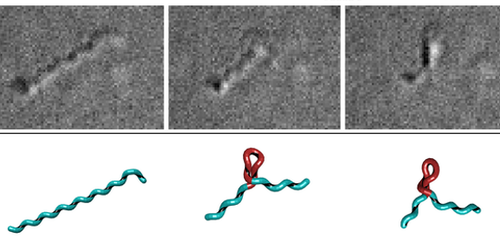Two Experimental Observations of Helix Reversals
Two research teams report the results of experiments on helices that undergo a transition from left handed to right handed or vice versa, and they developed models to explain them. One team observed helical Spiroplasma bacteria, which use handedness transitions for propulsion, finding results that could help others better understand the bacterium’s unusual locomotion [1]. The other team built an apparatus that can unwind and reverse the handedness of a plastic helix and can measure the forces involved [2]. These researchers found that when the helix exists in a partially right-handed and partially left-handed state, it exerts a steady torque that could potentially be used in robotics.
There are two independent ways of creating a helix from a straight rod: curl the rod into a circle and then twist the rod all along its length to convert the ring into a helix (“twist” method), or deform the rod into a sine wave and then bend it with a sinusoidal distortion that curls at right angles to the first sine wave (“bend” method). Both procedures produce the same shape, but they generate different internal stresses within the rod, and their implementations require different amounts of energy.
The helical bacterium Spiroplasma propels itself by periodically initiating a handedness reversal that propagates along its length from one end to the other. To understand the microscopic forces involved in the process, Charles Wolgemuth of the University of Arizona and his colleagues performed simulations and carried out experiments using 104 bacteria swimming in fluids with a range of viscosities.
Analyzing 1100 reversals of real bacteria and over 400 of simulated bacteria, the researchers looked for plectonemes—locations where the body of a bacterium folds over onto itself and two segments twist together, as one might see in a highly twisted rope or an old-fashioned telephone cord. They found that the bend method of helix formation predicts the conditions for plectoneme formation more accurately than the twist method. The team hopes that identifying the helix formation method and the associated internal stresses will help researchers trying to understand how the bacterium controls this locomotion at the molecular level.
For the plastic helices, the handedness reversal was forced by an experimental apparatus. Dražen Zanchi of Paris City University and his colleagues built a device that keeps one end of an object fixed while rotating the other end. They began with a deformable helix and “unwound” it until it retwisted into the mirror image of its original configuration. The team developed a model to explain the phases of the helix (right handed, left handed, and mixed) and the forces and torques exerted by the helix on the apparatus throughout the unwinding process.
The researchers say that their experiments could serve as a model for many physical systems that undergo handedness transitions, including the tendrils of plants, the flagella of microorganisms, and the strands of DNA molecules. For robotics, in some situations it’s useful for an actuator to maintain a fixed torque, even if the number of turns in the helix changes as it operates, Zanchi says. He and his colleagues found that the torque generated by the mixed state of a partially unwound helix is independent of the number of turns over a large range, so this configuration could benefit actuator designers.
–David Ehrenstein
David Ehrenstein is a Senior Editor for Physics Magazine.
References
- P. M. Ryan et al., “Bend or twist? What plectonemes reveal about the mysterious motility of Spiroplasma,” Phys. Rev. Lett. 131, 178401 (2023).
- É. Dilly et al., “Traveling perversion as constant torque actuator,” Phys. Rev. Lett. 131, 177201 (2023).





